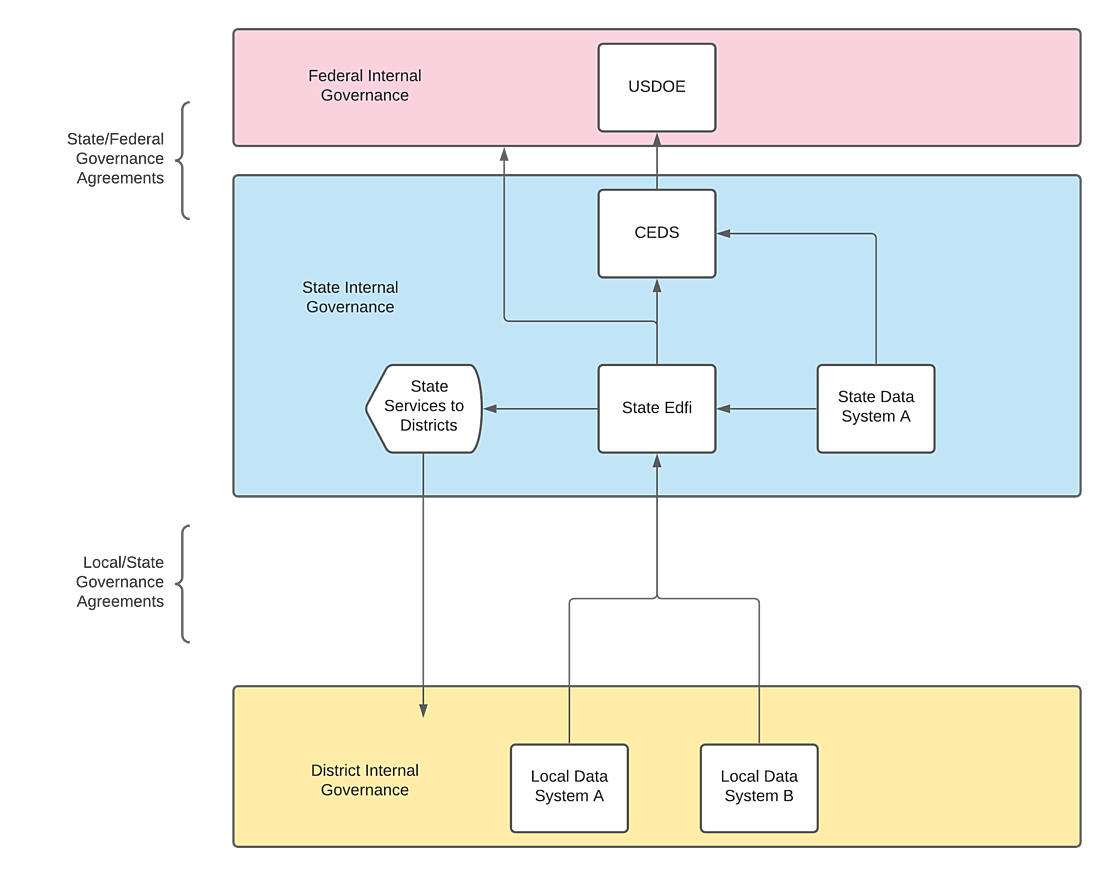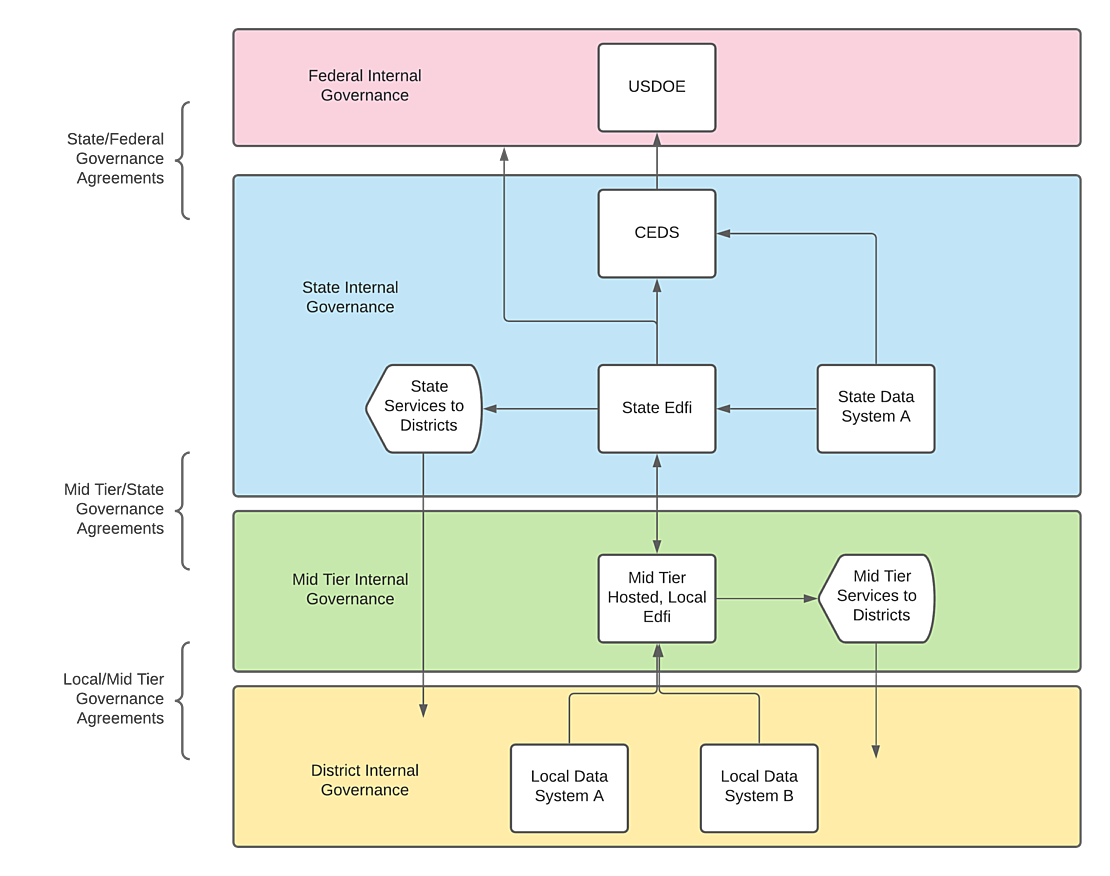Prioritizing District Perspectives
When faced with the need to rebuild the state’s data infrastructure, the South Carolina Department of Education (SCDE) didn’t simply want to meet the needs of the state, but also sought to balance that need with maintaining districts’ agency. The SCDE forged a path to allow their data infrastructure to meet the state’s compliance and monitoring requirements, while further offering support and leadership to districts. Rather than merely setting up a state data system that wasn’t useful to the districts themselves, the SCDE prioritized the districts’ needs and use cases for data to provide the infrastructure as a service—and not simply as a compliance mechanism.
A key design feature of this system is, in fact, the districts’ agency. The state has its minimal requirements for monitoring and compliance, but districts are not expected or required to contribute or engage more than what is required if they don’t have a need to do so. For those districts wanting to take advantage of a robust, standards-based data system that can streamline and expedite their data collection and analytics, that service is available to them.
The result is a system designed to make the work that districts need to do with data for the state as seamless, easy, and cost-effective as possible. By design, the infrastructure maintains local flexibility and privacy of data, while building buy-in for data standardization across the state.
Areas of Expertise
Other Project Partners
- Ed-Fi Alliance
A New Model for a Statewide Data Infrastructure
When the National Center for Education Statistics initiated the Common Education Data Standards (CEDS) in 2009, this marked a major innovation in the world of educational data; CEDS provided a core structure to enable and support interoperability among different datasets and data systems. CEDS wasn’t tied to any one interoperability standard, like Ed-Fi, but instead laid the foundation across multiple standards (including Ed-Fi, SIF, and IMS data standards).
The Ed-Fi Alliance emerged as an instrumental organization for supporting states and districts as they set up and launched interoperable data systems. Before South Carolina embarked upon their Ed-Fi implementation with EA, a set of states had tried out different models for implementing Ed-Fi. One was a centralized model, where a state built a central Ed-Fi operational data store (ODS), or data system, and then arranged for each district to connect to that central ODS individually. Another model included collaboratives of districts setting up Ed-Fi systems for each individual member district and then creating interoperability among them without direct involvement from a state education agency (SEA). In our collaboration with South Carolina, EA sought to blend the best of both models by building a state system and local systems, in order to meet the data needs of both the SEA and the local education agencies (LEAs). This blended model approaches data infrastructure as a service provided by the SEA to LEAs, which also helps ensure local control of data, maintain local agency, and remain responsive to local policy.
This first diagram illustrates the infrastructure that CEDS enabled, between the federal and state government levels, and that Ed-Fi has enabled, between the state and district levels.
And this second diagram illustrates what EA and South Carolina have built, as part of this new blended model of data interoperability. Importantly, a mid-tier governance structure is built in to enable joint data governance, state-district collaboration, state funding of infrastructure for local use, and mid-tier funding of infrastructure beyond what is paid for by the state.
To enable this mid-tier governance, the Michael & Susan Dell Foundation provided funding to the SCDE to establish a separate non-profit entity with full oversight of data governance. This innovative step maintains a separation between the state and the data system, which ensures true local control and local flexibility for the districts within the state. In cases where the state and the districts have differing priorities, this separately staffed organization is responsible for building solutions that represent the districts’ priorities. The result is a system that is lower cost, more collaborative, more transparent, and more locally controlled than the traditional statewide infrastructure that has come before it.
Although this governance structure itself is innovative, it wouldn’t even be possible without the underlying technology needed to support it. Because the Ed-Fi Alliance had prioritized making their tech stack open source, it became viable, for the first time, to build a flexible, cloud-based Ed-Fi system to accommodate multiple districts—without incurring the large costs that it took to create this system previously. Furthermore, it made it possible for South Carolina’s mid-tier governance to be managed by a small team as a singular entity, instead of as 80 individual districts with 80 separate connections from their local data system to the Ed-Fi ODS.
One of the biggest challenges in this work has been navigating the thorny issues related to data governance—in other words, who “owns” a given piece of data, like a student ID or a student’s demographic information? What happens if two different source systems disagree with one another? These issues are both big, philosophical ones requiring a broad perspective and nuanced, technical ones requiring deep expertise in data and technology. Building a system that works for stakeholders at every level of the system—from students and parents to building administrators, district administrators, and state-level staff—means weighing and balancing tradeoffs while never losing sight of the ultimate goals of strong data governance and positive impacts on students. These data governance issues don’t ever go away, but instead require a continual focus on always asking the questions, “Who should be in control of this piece of data at any given point? Why? Who makes that decision?” This has guided our implementation with South Carolina.
Several elements made this work with South Carolina more tenable, including support from the Ed-Fi Alliance, the presence of a statewide student information system (SIS), the groundwork that South Carolina laid for years prior to the pilot of this new system, a strong and transparent partnership between the SCDE and EA, and a single point of contact between EA and the SCDE for the Ed-Fi integration.
By the end of the first year of this three-year project, we launched one of the largest deployments of the Ed-Fi open-source tech stack. Every district in the state has a local Operational Data Store (ODS) that is up and running. At the same time, EA was awarded the Ed-Fi Alliance’s ODS/API managed platform badge—one of only a few organizations that have attained this recognition.

In the 2021-22 school year, we'll be creating a "sandbox" for South Carolina vendors to test their ability to comply with the SCDE Ed-Fi system requirements. We will also be pilot testing a statewide reporting system that reports the same information the state always has, but now uses the new interoperable state data infrastructure. This new reporting system will fully launch in the 2022-23 school year. Finally, we plan to build a de-identified data mart built off of the ODS that educational researchers will be able to use for any conceivable research project that is approved with state data, and that can be used for training the next generation of educational data scientists.
Working on a statewide implementation of Ed-Fi has taught me so much, especially about what is needed to properly communicate to stakeholders what it means to fully take advantage of an interoperability standard in education. Even as we continue to learn and grow our knowledge at EA about Ed-Fi and its capabilities, having a thought partner in SC that trusts us to provide our technological and subject matter expertise makes all the time spent in that joint learning more than worth it when we can put our collective vision out into reality.

EA’s support in our Ed-Fi implementation has gone well beyond providing technical expertise and guidance. They are also collaborative problem-solvers and thought partners. Working closely with the EA team has helped us deepen our understandings about what interoperability is and how students can be supported over time with our developing data infrastructure. What’s more, the team brings a positivity to the work that keeps us inspired even when we need to go into the weeds.
What Lies Ahead
EA deeply values our partnership with the South Carolina Department of Education, as it has allowed both of our agencies to trailblaze new paths towards innovative data reporting that wouldn’t be possible for either of us to accomplish alone. Our Ed-Fi implementation lays the groundwork for an almost infinite number of future projects together, as it will allow EA and the SCDE to easily inhale, process, and display almost any kind of educational data in almost real time. In addition, the infrastructure we have built together can become a model for states and collaboratives of districts across the country, as they look to improve and innovate their own systems for collecting, analyzing, and reporting educational data to all of their stakeholders.



